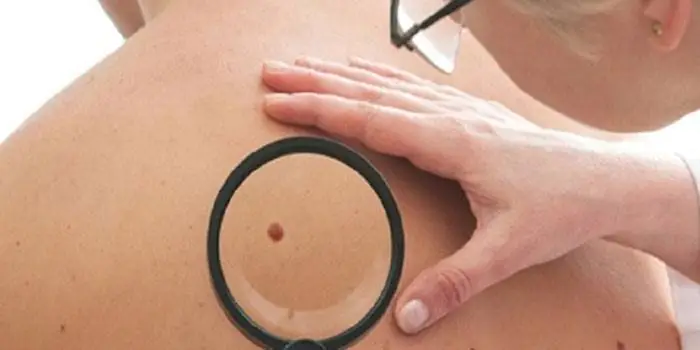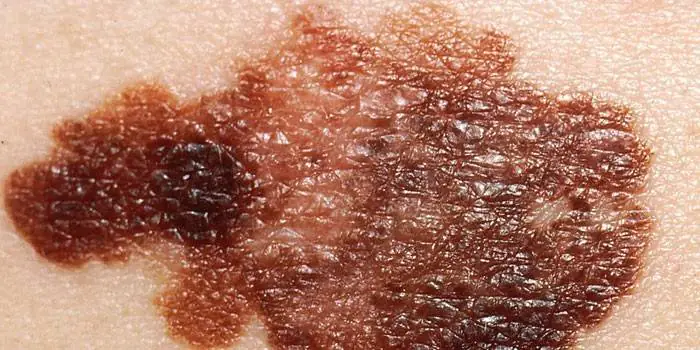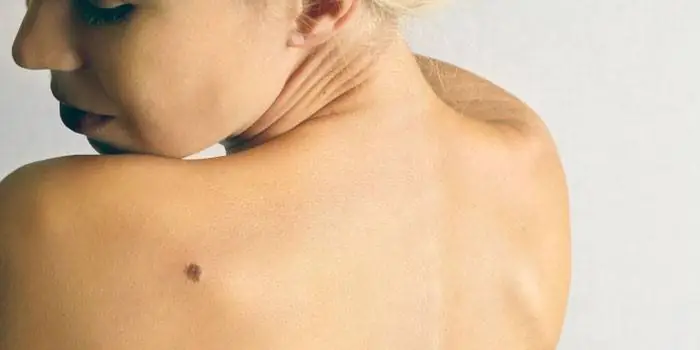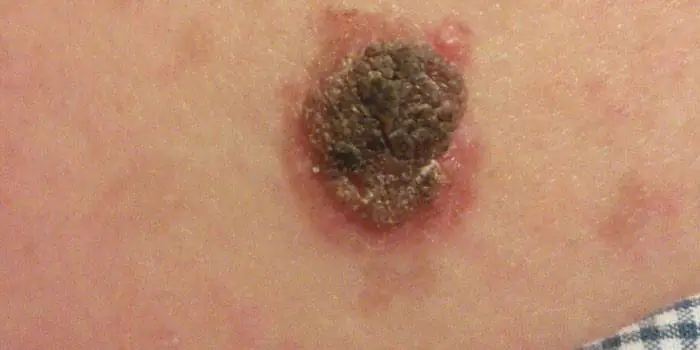The human body is covered with a large number of moles and birthmarks, which in the vast majority of cases are benign. The risk of degeneration into a cancerous tumor is very low; birthmarks and nevi do not threaten health. A black mole can also be “ordinary,” but it requires a more careful approach. You need to consult with a specialist (dermatologist, oncologist) who will conduct a differential diagnosis and determine whether it is melanoma-dangerous.
Causes of moles
Most moles form in childhood and adolescence. Heredity and genetic predisposition play a key role. In adulthood, the appearance of new formations is facilitated by external and endogenous factors. The most important is hyperinsolation - regular and prolonged exposure of the skin to ultraviolet radiation.
Ultraviolet light is the main catalyst for the formation of melanin pigment in skin cells, and it is melanin that determines the color of the entire skin and its elements. The appearance of a black mole may be a consequence of too frequent and long exposure to the sun. Fans of artificial tanning are at risk, since solarium lamps are a source of intense ultraviolet radiation.
Changes in hormonal balance can contribute to the appearance of new nevi. For women, a risk factor is ovarian dysfunction (imbalance of sex hormones). Changes in hormonal levels can be triggered by taking oral contraceptives and hormone replacement therapy during menopause. The formation of black moles is possible during pregnancy and lactation.
Dangerous symptoms
Only a very few black moles pose a potential threat. The risk of malignant transformation to melanoma is low, but caution should be maintained. In any case, it is advisable to show the skin lesion to a specialist. You definitely need to see a dermatologist or oncologist if you have the following symptoms:
- The black mole increases in size. Even small growth should be alarming; a rapid increase in size is an unfavorable sign.
- The surface has changed (becomes “glossy” or loose).
- The formation peels off or bleeds.
- Unpleasant sensations appear in the form of pain, burning or itching.
- The shape has changed, the edge has become striated, uneven, asymmetrical.
- The color changes: an ordinary mole becomes black, bluish or dark brown.
Any dynamics should be alarming. There is no need to panic, but you need to make an appointment with a specialist. What you definitely cannot do is try to remove the tumor yourself using traditional medicine. Injury by mechanical or chemical influence is one of the main causes of malignant degeneration.
Melanoma-dangerous nevi
Listed below are specific types of black moles that are melanoma-dangerous. This means that when exposed to unfavorable factors, they can degenerate into melanoma; the risk of malignant transformation is higher than in the case of ordinary nevi.
Dysplastic nevi. This type of nevi is characterized by the presence of melanocytic dysplasia, an atypical arrangement of melanocytes. Only a dermatologist can diagnose melanocyte dysplasia. The patient needs to know that a dysplastic nevus has a smooth surface. It does not rise above the skin, or only its central part rises. The shape is irregular, with uneven edges. The coloring is uneven, with black areas located in the center.
Blue nevus. Despite the name, the formation can be not only blue, but also black. Usually has the shape of a regular hemisphere and rises above the surface of the skin. The surface is smooth, the edges are even. Typical localization is the scalp, feet and hands, and gluteal region. The risk of malignancy increases after injury, including independent attempts at removal.
Nevus Ota. This type of tumor appears only on the face. Characteristic mainly for representatives of the Mongoloid race. The color is black or bluish. The differential sign is the presence of pigmentation of the sclera, iris or conjunctiva of the eye.
Borderline pigmented nevus. The neoplasm is formed in childhood. Subsequently, birthmarks increase in size throughout life, reaching one and a half to two centimeters in diameter. The differential feature is an uneven ring-shaped coloration, with a decrease in color intensity from the center to the periphery. The color is brown, darker in the central part.
Giant pigmented nevus. Refers to congenital. Increasing in size, such birthmarks reach gigantic sizes, up to 15 centimeters or more. A characteristic feature is an uneven surface with “potholes”, nodules and cracks. Hair growth from the nevus may occur.
For melanoma-dangerous moles, the risk of malignancy is higher than for ordinary skin tumors. Such nevi and birthmarks require observation by a dermatologist or oncologist. Malignant degeneration can be caused by exposure to external factors - mechanical or chemical damage, ultraviolet irradiation.
Diagnostics
If you have a black mole on your body, it is not at all necessary to remove it, but you need to contact a specialist. The dermatologist will conduct a diagnosis, which consists of examining the neoplasm and studying it using optical or digital dermatoscopy (under magnification).
During the examination, the doctor evaluates the size of the tumor, its density, structure, consistency, surface character, symmetry, edge, color and other signs. As a rule, examination and dermatoscopy are sufficient to make a diagnosis. Biopsy and histological examination are carried out only before removal. In other situations, dermatologists prefer not to injure black moles unnecessarily.
Treatment: removal or observation?
Benign neoplasms of the skin do not require removal, but surgery can be performed for aesthetic reasons, as well as in situations where the nevus is located in an open area of the body, is exposed to ultraviolet radiation, or is injured by parts of clothing or jewelry.
Removal of benign black moles that are not melanoma-dangerous is carried out in the following ways:
- Surgical removal;
- cryodestruction;
- electrocoagulation;
- radio wave removal;
- laser removal.
Melanoma-dangerous nevi can only be removed surgically. The operation is performed in the presence of an oncologist and involves healthy skin. The removed tissues are necessarily sent for histological examination. Melanoma-dangerous nevi can also be removed in aesthetic medicine clinics if the medical institution has a dermatologist oncologist on staff. The operation is performed in a classical way; cryodestruction and other modern technologies are not used.
If malignant degeneration of the neoplasm is diagnosed, complex antitumor therapy is indicated, which includes surgical removal with wide coverage of adjacent tissues, radiation and chemotherapy.
After the procedure
After removing a nevus, it is extremely important to protect the skin from ultraviolet radiation. You can’t sunbathe in a solarium; you should be in the sun as little as possible. It is recommended to refrain from thermal procedures. It is impossible to remove crusts at the site of the surgical wound; the skin should be provided with maximum rest. After removing a mole on the face, it is not advisable to use decorative cosmetics.
You can learn more about the diagnosis of skin tumors and methods of their treatment at a consultation with a dermatologist at the Galaktika clinic (Moscow).
A mole is a benign formation. The spots can be located on any part of the body of both an adult and a small child. If the mole has darkened, this indicates that a large amount of pigment, namely melanin, has begun to accumulate in it. Sometimes this may mean that there is a pathology in the human body. However, doctors who specialize in moles argue that a black mole does not always mean that a person has developed cancer.
Reasons for appearance
If a person has a black mole on his body, only a doctor can tell you what it is, whether it is dangerous, and what measures to take. It will also indicate that if the nevus is about 5 mm in size, its shape is correct, there is no bleeding, no roughness, then this formation is benign. There are cases when a black nevus forms in a baby at birth. This phenomenon indicates some characteristics of the body.
In order to understand why black dots appeared on a mole, you should consider some factors influencing this phenomenon. These include:
- Hereditary factor. Medical practice proves that birthmarks are inherited among close relatives. So, if one of the parents has a dark growth on the back, stomach or foot, the child has a formation with a similar localization.
- The influence of ultraviolet rays. Supporters of tanning under the scorching sun for a long time should remember that such a hobby contributes to the formation of new nevi, or the blackening of existing ones.
- Skin injury. If the mole turns black, it may indicate that a recent injury has occurred. Damage can be caused by scratching the growth, tearing or pressing hard.
- Hormonal imbalance. A change in the color of the formation can appear during pregnancy, during adolescence, when puberty begins. And also upon the onset of menopause, treatment with hormonal drugs, or the use of birth control pills.
Are black moles dangerous?
To protect yourself from the occurrence of cancer, you should regularly visit the office of a dermatologist or oncologist, and also independently monitor any changes in the black or blackened formation. It is important to remember what types of nevi there are in order to be able to distinguish a malignant formation from a regular nevus. These include:
- Small dark spot. In rare cases, it is dangerous to humans. Often its occurrence is associated with the systematic influence of certain factors. For example, ultraviolet rays. The neck, arms, legs, face, scalp, and back are exposed to ultraviolet radiation.
- Dysplastic mole. More dangerous than a regular nevus. It is formed on those areas of the skin that are not exposed to ultraviolet rays. They have a flat surface. Most often, their edges are uneven. The shade of this formation can vary from light brown to black. Rarely does a slight bulge occur.
- Melanoma. Refers to cancer. Melanoma spreads across the skin at a rapid rate. Such a formation can be covered with patches of various colors. A malignant nevus will hurt and swell to a large size. In parallel with these symptoms, the tumor will turn black and itch, causing severe discomfort to the person.
If a person notices that more than 5–7 black formations have appeared on the body, this is a reason to consult a doctor. At a medical facility, the patient will be prescribed a biopsy to identify or rule out the presence of cancer cells inside the nevus. It follows that if you have the following symptoms, you should immediately visit a specialist:
- the surface of the nevus began to become covered with a crust;
- blood appears in the area of the nevus;
- the top layer of the mole began to peel off;
- if the size of the formations suddenly begins to increase or decrease;
- with hair loss on a mole that was previously there;
- if itching or swelling occurs;
- if the formation has become hard to the touch.
A timely visit to a doctor will help identify the pathology at the stage at which it can easily be treated or removed. This also applies to hanging nevi, supported by a small stalk, which are subject to constant mechanical stress. If accidentally injured, the surface of the mole will turn black. This is due to the lack of blood flow to them. Often the damaged hanging growth dries out and then falls off.
Are black dots on a mole dangerous?
If a black dot appears on a mole, this may indicate that the process of degeneration of a benign formation into a malignant one has begun. The main factor in the occurrence of transformation is the negative impact of ultraviolet rays. This is explained by the fact that melanin cells are not able to withstand ultraviolet radiation, resulting in a mutation into cancer.
It is dangerous for people with fair skin to be exposed to open sunlight for a long time, especially from 10 am to 5 pm, when the rays are most aggressive. Along with the appearance of black spots on the body, similar to moles, a person may experience a number of certain symptoms. Such signs require immediate contact with a specialist. These include:
- The nevus began to become inflamed, changing its size.
- The black dot is located in the center of the mole.
- The surface of the growth becomes covered with cracks through which blood or pus appears.
- The skin around the nevus became dry and rough.
- Loss of hair that is on the growth.
- On palpation, compaction and pain are felt.
Black birthmarks on human skin are divided into several types. It is worth considering each of them in more detail:
- Hutchinson's freckles. The size ranges up to 10 centimeters. It can occur in older people. Does not have clearly defined edges. It develops slowly, so the human immune system is able to independently fight cancer nevus.
- Superficial spreading nevus. It is dangerous because with such formation metastases appear. A small spot begins to grow. Brown color changes to black. In the absence of medical care, the formation will hurt, and if injured, purulent discharge with bloody inclusions will be released.
- Nodular melanoma. The most dangerous species. It develops faster than other formations. If melanoma is not treated, a person faces death.
Survey
If a black formation appears on the body, you should seek help from a qualified specialist. He will examine the mole using a dermatoscope. The device allows you to enlarge the image of the nevus tens of times, which will help to clearly determine the structure and condition of the formation. After dermatoscopy, the doctor will give recommendations based on removal or treatment of the mole.
If the patient is indicated to remove the blackened tumor, he will undergo the appropriate operation. After surgery, the removed growth will be sent for histological examination. Histology allows you to determine whether the birthmark was malignant or not.
In what cases should a mole be removed?
The question of removing a nevus can only be decided by a specialist. The exception is when the growth is localized in a visible area of the body, which spoils the aesthetic appearance. If a person discovers one or more alarming signs, he should immediately visit a dermatologist. Namely:
- the size has changed up or down;
- itching and pain appeared;
- the edges have acquired a fuzzy outline;
- the nevus is swollen;
- the area around it is red and bleeding;
- the surface of the formation began to peel off.
Self-removal can have dangerous consequences for human health and life. Modern medicine can provide several methods for removing a mole. These methods include:
- Laser removal. The use of laser is painless and does not pose any danger. After the procedure there will be no scar or scar, so the procedure has many positive reviews.
- Cryodestruction. This method involves the impact of liquid nitrogen on the site of inflammation. The growth cells are completely destroyed.
- Electrocoagulation. High-frequency electric current is used as a destructive factor.
- Exposure to radio waves. Refers to a gentle method. As a result of exposure to radio waves, benign cells are destroyed.
After performing one of the listed procedures, the doctor will give recommendations on wound care. He will also advise you on how to behave in order to avoid the occurrence of blackening of nevi, their injury and transformation into a malignant tumor.
Black mole in a child
If a child has a black nevus, you should pay attention to this and contact a pediatric dermatologist. Typically, such formations are benign in nature, but under the influence of certain external and internal factors, there is a risk of degeneration into a malignant tumor. Signs indicating transformation into melanoma include an increase in the size of the growth, redness, swelling, and peeling. An important factor is the state of the child’s immunity and the duration of exposure to the sun.
Blackening of a mole in a child can occur as a result of scratching it. In this case, it is necessary to disinfect the wound and consult a dermatologist. The doctor will conduct an examination and prescribe appropriate treatment or removal of the growth. This will avoid complications such as cancer.
It's rare to see a person without small dark marks on their body. Is it worth paying attention to these points? Only a doctor will distinguish between dangerous and normal moles - malignant melanoma or harmless nevus - and give recommendations on what to do with them. Is it worth worrying about the appearance of new formations, when immediate contact with specialists is required, what are the signs of cancer development - the answers to these questions remain to be found out. No one is immune from disaster, and early diagnosis will protect you from severe consequences.
What is a mole
The first tiny spots may appear in children in infancy. A mole is a small formation on the skin - a nevus - that is considered benign and harmless. The basis for their appearance is melanocyte cells that accumulate the natural pigment melanin. Depending on its quantity, a difference in color is observed. Available colors:
The shape of the tumors depends on the location and concentration of melanin. They may have a stalk or be located under the skin, be flat and convex. The most common type is round, but there are exceptions. The development of neoplasms is provoked by ultraviolet radiation - natural from the sun, in a solarium. Hereditary factors cannot be excluded. A common cause of growth is hormonal imbalance, characteristic of periods:
- puberty;
- pregnancy;
- menopause.
What types of moles are there?
One person may discover very different tumors. Types of moles are classified according to several criteria. This helps in correct diagnosis in case of changes. They differ in:
- origin– congenital, newly acquired;
- structure– pigment, vascular;
- place of education – in depth, on the surface, in the boundary layer;
- raised above the skin – flat – even, protruding as a hemisphere, pedunculated, larger birthmarks;
- potential threats – dangerous, degenerating into melanoma, non-dangerous.

Safe moles
Those who have dark spots on their skin should be wary of their changes. In time, detected signs of degeneration into melanoma contribute to the timely removal of the formation and preservation of health. Safe moles are different:
- the presence of a stalk – it cannot be formed by malignant cells that grow randomly;
- long-term condition without changes.
Spots that appear soon after birth are not considered dangerous. It is important that they are small in size. Good – non-dangerous – signs of neoplasms include:
- flesh tone;
- unchanged pattern of the skin of the nevus and adjacent tissues;
- soft consistency;
- hair on the surface of the neoplasm - growing from the skin, indicates the absence of pathologies;
- diameter no more than 5 mm;
- symmetry;
- nevus in the form of a spot.
Which moles are dangerous?
Why do people with nevi on their bodies need to monitor their changes? There is always a threat of degeneration of non-dangerous tumors into a cancerous tumor. What moles are dangerous to health? Key signs you need to know:
- change in shades towards the dark side, the appearance of multi-color;
- rapid increase in size - exceeds two millimeters per year;
- occurrence of cracks;
- the formation of asymmetry due to uneven growth;
- lack of elasticity;
- the appearance of itching, burning;
- presence of discomfort.
The appearance of dangerous moles requires an immediate visit to a specialist to clarify the nature of the changes and the likelihood of developing skin cancer. Pathological transformations provoke:
- injury to the nevus due to negligence;
- self-removal;
- abuse of exposure to the sun, use of a solarium;
- location of the formation in places of frequent contact with clothing - on the neck, head, genitals, legs;
- placement in the hair, on the face, palms - where there is a high probability of injury;
- previously removed melanoma.

Why are moles dangerous?
Not a single person is protected from the sudden proliferation of cells of a harmless mole. Melanoma is an extremely serious disease. Changes not detected at the initial stage can result in death. The provoking factor is unsuccessful independent removal of tumors. Moles are dangerous because of their ability to:
- transform into an atypical – precancerous form;
- grow to large sizes;
- turn into cancerous;
- with minor external changes, metastases actively spread throughout the body through the circulatory and lymphatic channels.
How quickly does melanoma develop from a mole?
The transformation of a nevus into a cancerous formation can occur in different ways. The process depends on the stage of the disease and the type of tumor. Instant metastases are dangerous. Begins:
- growth of cancer (oncological) cells in the deep layers of the epidermis;
- their entry into the blood and lymph;
- penetration into the lungs, liver, kidneys;
- growth in these organs;
- complete damage to the body;
- death.
The growth phases of pigment cells are observed, along which melanoma develops from a mole. There are varieties:
- horizontal– damage to the upper layers of the skin occurs, lasting up to 10 years, but metastases do not appear;
- vertical– accompanied by the spread of cancer cells throughout the organs, can last two years, has an unfavorable prognosis;
- nodal – especially dangerous – characterized by deep spread within two months.

The first signs of melanoma
The patient can be assisted only when suspicious changes begin to be identified. The diagnosis, research, and referral for surgical treatment save a person’s life. The first signs of melanoma:
- increase in the height of the tumor;
- bleeding;
- the appearance of discharge;
- redness;
- burning, itching;
- swelling of tissues;
- softening of the nevus;
- the appearance of a crust;
- thickening;
- hair loss;
- expansion of pigmentation around the lesion.
With the further development of dangerous melanoma, the following are observed:
- significant change in size;
- the appearance of pain;
- enlarged lymph nodes;
- surface ulceration;
- formation of new foci;
- bleeding from places of pigmentation;
- liquid separation;
- skin thickening;
- the appearance of an earthy tint;
- signs of metastases are chronic cough, weight loss, cramps, headaches.
How to distinguish a mole from melanoma
To recognize which moles are dangerous and which are not dangerous, you need to know what they look like. A person with nevi, in order to avoid dire consequences, must constantly monitor the appearance of new formations and changes that occur. You can distinguish a mole from melanoma by its signs. Non-dangerous neoplasm:
- symmetrical;
- with smooth edges;
- uniform in color;
- with dimensions not exceeding 6 millimeters.
Features of dangerous melanoma that require seeking help from dermatologists:
- growth in a short time;
- pronounced asymmetry of shape;
- heterogeneity in color - the presence of inclusions of several shades;
- lack of clear boundaries - the contour line is blurred, jagged, and looks like a coastline on a geographical map;
- increased diameter over six millimeters;
- variability of any parameters - color, size, shape.

What dangerous moles look like
What do nevi that are subject to pathological changes look like? Only a doctor can correctly distinguish between non-dangerous tumors. Dangerous formations look like this:
- blue– compactions under the skin with clear boundaries, with dimensions no more than 10 mm;
- nodal– round, flat in shape, color – brown, black;
- cutaneous– often pale, convex;
- halo nevus – pigment surrounded by a light or white rim;
- spitz- looks like a dome-shaped tumor of pink shades, with the possible presence of a hole through which blood and liquid leak;
- connecting- connect individual entities into a whole.
Mole with jagged edges
One of the signs of a non-hazardous formation turning into a dangerous one is a change in contours. It often has blurred edges and scalloped borders. There are non-dangerous types of nevi - dysplastic. Only a specialist can make a correct diagnosis. A mole with uneven edges can be dangerous if there are additional signs of melanoma:
- accelerated changes in size;
- the presence of clearly defined asymmetry;
- the appearance of highly indented boundaries.
Rough mole
Such a neoplasm is harmless if its diameter is no more than 5 mm and remains constant in size. Often its appearance signals a lack of vitamins and nutritional disorders. Doctors advise coming for a consultation if it is discovered that:
- the smooth nevus turned into a rough one;
- bothered by burning, itching, tingling;
- irregularities and compactions appeared in the middle;
- areas with different shades formed;
- diameter has increased significantly.
A dangerous rough mole requires immediate examination if:
- the appearance of bleeding;
- development of the inflammatory process;
- rapid change in size;
- formation of asymmetry;
- formation of purulent discharge;
- the occurrence of painful sensations when touched;
- the emergence of an irregular shape, blurred boundaries, along the edges of the neoplasm.

Large moles
Large formations on the skin are pigment spots. When they remain unchanged and do not cause inconvenience, this is not a dangerous phenomenon. It is important to constantly monitor their appearance, color, and size. To eliminate worries, you need to consult a dermatologist. During the visit, the specialist will conduct a diagnosis and give a forecast of the risk of developing a malignant neoplasm. Large moles become dangerous if they:
- injured;
- thickened;
- started to itch;
- were unsuccessfully removed independently;
- changed in size, shape;
- are bleeding.
What moles can be removed
Often nevi cause trouble for women when they are in a visible place - the face, neck. Even if they do not bother you, using removal will be the right decision - the appearance will improve significantly. After the procedure, the doctor must necessarily send the tissue for histological analysis to decide whether the mole is malignant or not. If the neoplasm is not dangerous, does not bother you, and does not change in size, surgery is not required. What moles cannot be removed? Experts believe:
- there are no contraindications;
- It is important to choose the right excision technique.
You should be careful about skin growths; it is unacceptable to remove them yourself. Only the doctor will determine whether a nevus is dangerous or not and decide what to do with it. You can delete it if:
- injured from clothing - on the neck, in the groin area, under the armpits;
- cause pain when touched;
- are located under the hair on the head and can be damaged when combing or cutting;
- change color, shape, outline;
- significantly increase in size;
- characterized by the presence of burning, itching;
- accompanied by inflammation and bleeding.



